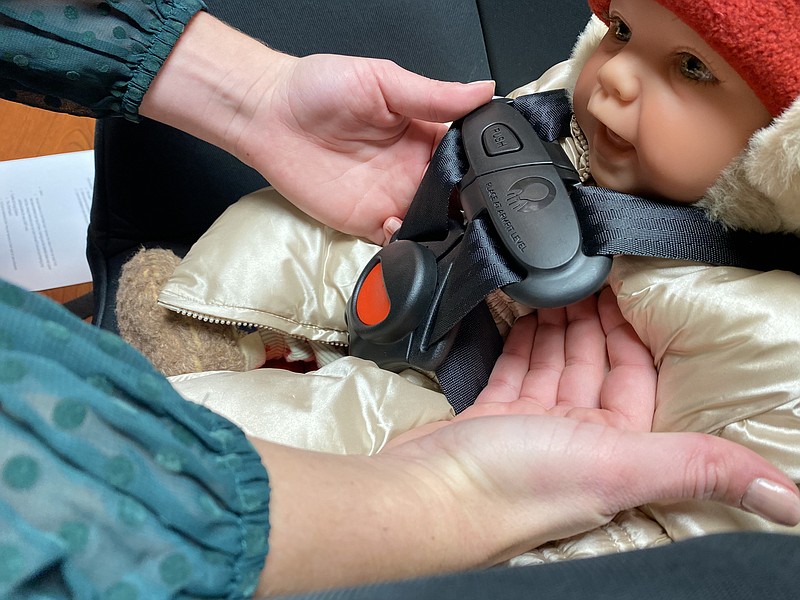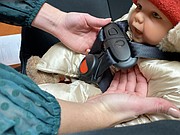While the holidays can be a joyous time for children, they also pose many dangers, such as toy safety issues and improper car seat use, according to officials at the Children's Hospital at Erlanger.
Lindsay Bass, pediatric trauma injury prevention and outreach coordinator at Erlanger, said during a safety demonstration Wednesday that puffy jackets and button batteries are particularly problematic.
When children wear thick clothing such as puffy coats, Bass said they may appear to be harnessed securely in a car seat. But in the case of a car crash, the clothing easily moves or collapses, leaving extra room for the child to propel forward.
"Now, we're no longer protecting the child's head, spine or neck," she said, adding that car accidents and injuries in general increase over the holidays as many families travel and children are out of school.
That's why Bass recommends children wear thin clothing layers while in the car seat. To keep them warm, she said parents or caretakers can opt to heat the car beforehand, put a stocking cap on the child's head and use a blanket or the coat itself to cover the child after they're securely fastened.
(READ MORE: Most small SUVs flunk updated insurance industry crash tests)
To be extra safe, parents can call 423-778-6691 to set up an appointment with Bass to check their car seat setup for free.
When it comes to toys, a report from the 2020 Consumer Product Safety Commission states that roughly 200,000 wind up in an emergency room each year due to toy-related injuries or illnesses.
Bass said button batteries, and small parts in general, are the biggest threat.
"Kids are able to get a hold of those, either from their toy or from an older sibling's toy, and they tend to put them in their mouth, nose or ears, which is a frequent stop to the ER," she said.
If swallowed, button batteries can burn through the lining of the esophagus and cause complications that lead to surgery and require prolonged use of feeding or breathing tubes. In rare cases, ingesting the batteries is fatal.
"Button batteries are very dangerous and cause a chemical burn when swallowed in up to one to two hours," Bass said.
(READ MORE: Audit finds Tennessee children in state custody in jeopardy)
A paper published in the journal Pediatrics this September estimated more than 70,300 children sought emergency care for battery-related injuries between 2010 and 2019 -- which is more than twice the number of visits between 1990 and 2009 -- an increase they attribute largely to the increased use of button batteries.
Signs of button battery injury include crying, loud breathing, coughing, discomfort, drooling, unwillingness to eat or drink and trouble swallowing. Some children may also vomit, experience stomach pain or have blood in their saliva or stool.
Bass said a good rule of thumb for any toy is that if the parts are small enough to fit through an empty toilet paper roll, it's a choking hazard.
While toys sold in the U.S. must meet certain safety standards, people should check the Consumer Product Safety Commission website for a list of recalled toys before giving to children, especially if the toy is bought secondhand or from a lesser-known seller online.
"It's illegal to sell recalled toys. Unfortunately, Facebook marketplace is responsible for 75% of all toys sold that have been recalled, the other major source being eBay," Bass said.
And even toys that have met U.S. safety standards can still cause injury when used incorrectly.
"Because they have to meet a U.S. safety standard, ideally they're made safe," she said. "But, not all toys are safe if they're used incorrectly, so supervision is key with every toy."
Safety tips
— Look for small parts that can break off and become a choking hazard, including balloons.
— Always store batteries and small magnets out of children’s reach.
— Secure tightly the backs of toys in which batteries are stored.
— Always read warning labels.
— Be wary of toys from unknown sellers.
— Look for sturdy plastics over flimsy ones, which easily break.
— Look for toys labeled non-toxic.
— Buy protective gear to go along with toys, such as helmets or protective eyeware.
— Consider the child’s age, age recommendation on the toy and the child’s skill level.
Source: Children’s Hospital at Erlanger
Contact Elizabeth Fite at efite@timesfreepress.com or 423-757-6673. Follow her on Twitter @ecfite.

